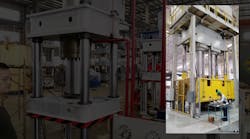Press Leveling and Cushion Control: Combining Force and Motion Control
Hydraulic presses and cushions often need to synchronize four or more actuators even if the load on the actuators is uneven. Engineers can make presses mechanically rigid so uneven loads will not skew the platen or slider too much, but mechanical synchronization often fails if loads are too uneven. Today’s presses and cushions often rely on hydraulic motion controllers to avoid skew. This requires simultaneously controlling force and position.
Controlling the force requires closed-loop control that compares the desired force set point to the sum of all the actuator’ forces. The output of the force closed-loop control is the target or master velocity, which is usually slow. The master velocity must be integrated to calculate a master position all slave actuators must follow. Each actuator follows the same master position, so they remain in line with little deviation. The deviation can be limited by properly tuning the inner position loops. There will be some skew, but it is usually extremely small and within the mechanical limits.
Presses
An operating press starts by moving down using a synchronized move command. It is common to have the press come down in open loop, with the prefill valve open; the controller is not controlling this part of the cycle. The transition out of this open-loop move into synchronization is critical in getting the actuators together. In this mode, the controller generates the same target position, velocity, and acceleration for all actuators to follow. The motion controller monitors the position of the actuators to ensure synchronized motion.
Usually this part of the motion is easy to control unless there is something mechanically wrong with the press. If the press is binding or a valve or feedback not working, the motion controller quickly detects these errors and ramps down the synchronized actuators to avoid further problems.
As the platen approaches the workpiece, it should slow so that its kinetic energy roughly matches the work that must be done on the workpiece <<
Usually a few conditions must be met before the motion controller goes into cascaded-loop mode. First is to ensure the press is close to making contact. It is important the press not go into force-control mode when the platen is too high because it will accelerate down rapidly trying to reach the force set point, possibly damaging the workpiece or tooling. Second, the force must be above a certain level, ensuring good contact with the workpiece. And third, the rate of force increase must be above some threshold.
When these conditions are met the press can change to cascaded loop control. Switching between synchronized-position mode to the synchronized-position force mode should be seamless. A major advantages of computer control is that where the press starts ramping down and the speed at contact can be easily changed to accommodate different parts of various thicknesses.
Cushions
Cushions, also called press leveling, are similar to presses because the actuators must be synchronized. They differ in that the cushion usually reacts to a force generated by a mechanical press. There are two things to limit or control that will vary from part to part. One is impact depth, and other is the force.
If the press must strike deep into the workpiece, contact must be before the bottom of the stroke. However, the impact’s speed and, therefore, the force may be too high. The difference between the positions of the platen at the bottom of stroke and the cushion is determined by the desired impact depth, so the cushion can only retract so far. To minimize the impact force, the cushion should start at a higher position and start retracting in anticipation of the impact, much like a baseball catcher handling fast balls. The cushion can then retract to the desired position.
It is impossible to control the force and position simultaneously without using the past to predict the future.
As stated in the previous month’s article, it is impossible for force control or limiting to react quickly enough to impacts if the cushion simply waits for them.
There are two ways to keep the impact force in the desired range, both of which require anticipation.
Technique 1: Mechanical presses are usually rotary, so up-and-down motion is sinusoidal. Before impact the platen’s vertical speed is slowing. This means its speed at the stroke’s top and bottom approaches zero. Before impact and after the bottom of the stroke, however, the velocity is higher.
Platen position can be monitored by an absolute encoder. This lets the cushion start retracting before impact to control the difference in speed between the platen and cushion. Slowing the speed of impact slows the rate of change of force applied to the workpiece. The cushions’ retracting motion should be geared to the encoder. How far the cushions should retract depends a lot on how deep the top die must go into the workpiece. The motion profile can be programmed using a cubic spline which results in a smooth retracting motion synchronized with the platen encoder.
Technique 2: The second way of minimizing force is to monitor forces from previous impacts and adjust the cushion position up or down accordingly. This method should be used simply because presses heat up when used, so the position at impact will change by a few thousands of an inch. That can make a big difference in the impact force. The starting position of the cushions motion profile can be offset slowly from stroke to stroke. If the impact force is too high, the motion profile should start slightly lower. Making the cushion adaptable requires some programming but will yield more consistent impact forces and accommodate workpieces that must be pressed to different depths.
To repeat part of the previous article: Closed-loop tuning should not need to change when switching from part A to part B, but impact velocities will need to change so the platen’s energy matches that needed to do the necessary work on the workpiece. Electronic controls make it possible to adapt to different work pieces.
Peter Nachtwey is president of Delta Computer System Inc.


